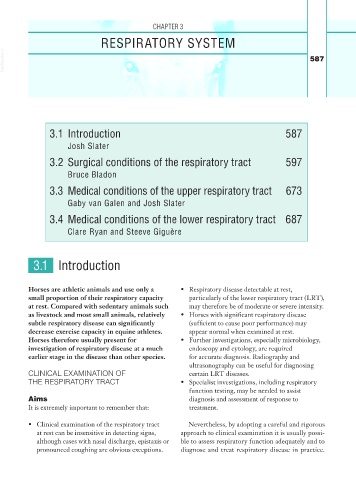Page 612 - Equine Clinical Medicine, Surgery and Reproduction, 2nd Edition
P. 612
CHAPTER 3
RESPIRATORY SYSTEM
VetBooks.ir 587
3.1 Introduction 587
Josh Slater
3.2 Surgical conditions of the respiratory tract 597
Bruce Bladon
3.3 Medical conditions of the upper respiratory tract 673
Gaby van Galen and Josh Slater
3.4 Medical conditions of the lower respiratory tract 687
Clare Ryan and Steeve Giguère
3.1 Introduction
Horses are athletic animals and use only a • Respiratory disease detectable at rest,
small proportion of their respiratory capacity particularly of the lower respiratory tract (LRT),
at rest. Compared with sedentary animals such may therefore be of moderate or severe intensity.
as livestock and most small animals, relatively • Horses with significant respiratory disease
subtle respiratory disease can significantly (sufficient to cause poor performance) may
decrease exercise capacity in equine athletes. appear normal when examined at rest.
Horses therefore usually present for • Further investigations, especially microbiology,
investigation of respiratory disease at a much endoscopy and cytology, are required
earlier stage in the disease than other species. for accurate diagnosis. Radiography and
ultrasonography can be useful for diagnosing
CLINICAL EXAMINATION OF certain LRT diseases.
THE RESPIRATORY TRACT • Specialist investigations, including respiratory
function testing, may be needed to assist
Aims diagnosis and assessment of response to
It is extremely important to remember that: treatment.
• Clinical examination of the respiratory tract Nevertheless, by adopting a careful and rigorous
at rest can be insensitive in detecting signs, approach to clinical examination it is usually possi-
although cases with nasal discharge, epistaxis or ble to assess respiratory function adequately and to
pronounced coughing are obvious exceptions. diagnose and treat respiratory disease in practice.

